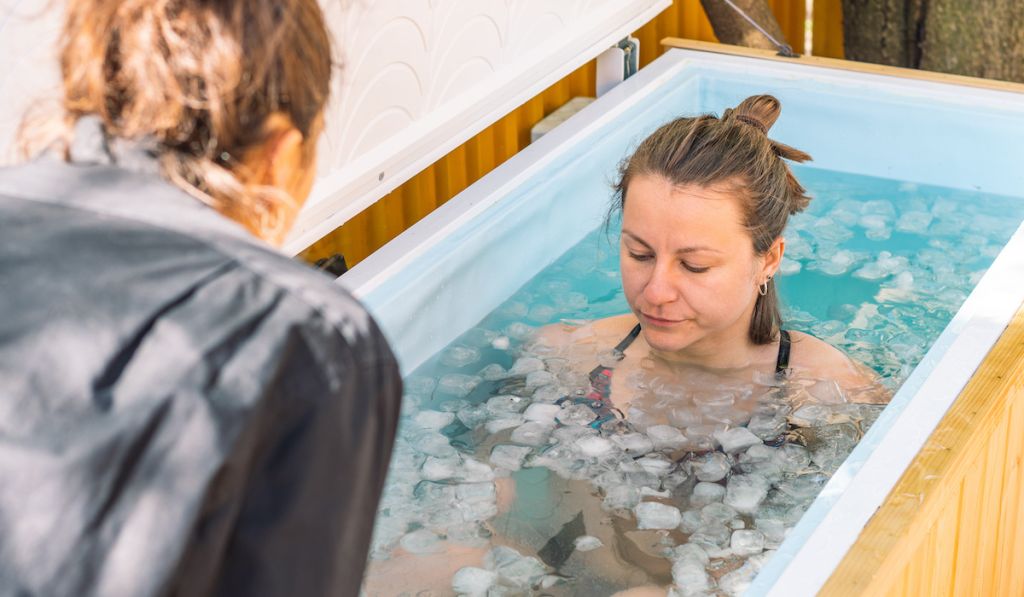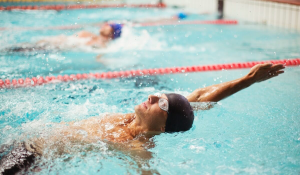Is Cold Plunge Therapy Worth Your Investment? Key Health Benefits & Water Treatment Considerations Before Taking the Plunge
Are you curious about whether the cold plunge benefits could level up your wellness game? With so many trends out there, it’s hard to know what’s worth your time, money and effort. If you’re wondering, “Is it really worth it?” – we’ve got you covered.
Whether you’re looking to maximize your health benefits of your cold plunge tub or thinking of buying one, we’re here to help you. We’ll explore the health benefits, practical tips and even what to consider for water treatment. Because let’s face it, nobody wants to waste money on a fleeting wellness fad or end up exposing themselves to more toxic chemicals, right?
Let’s dip into everything you need to know about cold plunge therapy.
What Is Cold Plunge Therapy?
Cold plunge therapy isn’t just about taking a chilly dip in the pool. It’s a wellness practice with deep roots and powerful effects on the body. Dating back centuries, this therapy taps into the natural power of cold water to invigorate and revitalize. When you immerse yourself, your body undergoes a fascinating response. The cold prompts your blood vessels to constrict, enhancing circulation and purging toxins. Meanwhile, your heart rate and metabolism soar, fueling your energy and overall well-being. It’s a refreshing wake-up call for your body, leaving you feeling alive and rejuvenated. So, why not embrace the chill and experience the transformative benefits of cold plunge therapy firsthand?
What Are the Cold Plunge Therapy Benefits?
Cold plunge therapy health benefits extend far beyond just feeling refreshed – it benefits your body and mind. Scientific studies and expert opinions have highlighted its profound impact on both physical and mental well-being.
Cold Plunge Benefits: Physical Health
Cold plunge therapy acts as a powerful stimulant for your body’s circulatory system. According to a Journal of Applied Physiology study, cold water immersion triggers an increase in blood flow by constricting blood vessels, leading to improved circulation and reduced inflammation. By enhancing circulation and reducing inflammation, cold plunges can support long-term cardiovascular health and immune function.
This improved circulation with cold plunges not only helps nutrients reach your cells but also promotes the removal of metabolic waste, promoting overall cellular health. For athletes, cold plunges are particularly beneficial as they help reduce muscle inflammation and soreness, facilitating faster post-workout recovery. Additionally, the enhanced immune response generated by cold plunge therapy strengthens your body’s defenses, making you more resilient against illnesses.
Cold Plunge Benefits: Mental Health
Cold plunge isn’t just invigorating; it can also improve your mood, stress and mental clarity. Cold exposure triggers the release of endorphins, those feel-good hormones that leave you feeling energized and uplifted. Studies, like those published by the European Journal of Applied Physiology, have linked cold water exposure to increased levels of beta-endorphins, which are neurotransmitters associated with feelings of well-being. Additionally, the cold plunge has shown to reduce stress levels and promote better sleep quality, leaving you feeling refreshed and mentally rejuvenated.
Cold Plunge Benefits: Long-Term
Integrating cold plunge therapy into your lifestyle is an investment in long-term wellness. Incorporating cold plunges into your regular routine can result in an increased metabolism, making it easier to maintain a healthy weight. Additionally, the stress-reducing effects of cold plunge therapy may contribute to better mental health over time. Overall, cold plunge therapy offers a natural and effective way to support your health and vitality for the long haul.
How to Cold Plunge (Safely): A Step-by-Step Guide
Adding cold plunge therapy to your routine may seem daunting, but it doesn’t have to be. Incorporating cold plunge therapy into your routine is all about consistency and finding what works for you. Here are some beginner-friendly tips to get you started:
- Start Slow: Begin shorter sessions 1-3 per week to see benefits without overdoing it.
- Schedule Regularly: To see full benefits, make it a part of your routine. Block out time in your calendar at the same time each week to establish a habit.
- Make it Enjoyable: Encourage regular use by making your cold plunge area inviting and comfortable, whether it’s adding music or treating yourself to a post-plunge reward.
Cold Plunge Therapy Process
Now, let’s break down the cold plunge therapy process:
- Cold Plunge Conditions:
- Duration: Aim for 1-3 minutes per plunge, gradually working up to 5 minutes as you become more comfortable. Don’t exceed 10 minutes per session.
- Frequency: Start with a frequency of 2-3 times per week, adjusting based on how your body responds.
- Temperature: Water temperatures typically range from 50 to 60 degrees Fahrenheit.
- Before the Plunge:
- Drink water to hydrate and promote circulation.
- Set a timer to keep track of your duration.
- Have towels or clothing ready.
- During the Plunge:
- Practice slow, controlled breathing to avoid hyperventilating.
- Don’t hold your breath, as it can increase the risk of cardiac arrhythmias.
- Don’t exceed 10 minutes per session.
- After the Plunge:
- Quickly dry off and wrap yourself in warm towels or clothing to avoid hypothermia.
- Engage in gentle movement or activities to raise your body temperature.
- Drink water to replenish fluids lost during the plunge.
What to Expect With Cold Plunge
Immediate Effects
What you’ll notice immediately:
- Instant Refreshment: You’ll likely feel invigorated and refreshed, thanks to increased circulation and endorphin release.
- Increased Alertness: Cold exposure triggers a wake-up call for your body and mind, leading to an endorphin high.
Long-Term Effects
With consistency, here’s what you see over time:
- Enhanced Recovery: Reduced inflammation leads to faster muscle recovery after workouts.
- Improved Circulation: Regular plunges promote better blood flow and circulation throughout your body.
How Do You Sanitize a Cold Plunge? What to Look For
Neglecting your cold plunge water sanitation or treatment method is a critical error. Your choice of water treatment can significantly help or hurt your cold plunge tub investment, time, health and therapeutic benefits. The last thing you want is to find your cold plunge investment damaged with corrosion or your water contaminated with harmful bacteria, algae, and other microorganism contaminants.
When choosing your cold plunge sanitizer, consider the benefits and drawbacks of each option. Let’s explore some popular cold plunge water sanitizers and their pros and cons:
Hydroxyl-Based AOP Cold Plunge Sanitation
Hydroxyl-Based AOP cold plunge (advanced oxidation process) systems use a patented technology that’s a “game-changer” in wellness. Unlike systems using ozone, UV or both, Hydroxyl-Based AOP is an easy-to-use alternative sanitizer that tackles “bather load” (lotion, dirt, sweat, etc.) with the lowest need for chlorine. The result is crystal-clear water that soothes your eyes, skin and breathing.
Hydroxyl-Based AOP injects powerful hydroxyl radicals into water, the same naturally-occurring molecules that clean the air we breathe. These radicals neutralize bacteria, viruses, pathogens and other contaminants that chlorine can’t fight off alone.
- Pros:
- Effective in freezing temperatures
- Lowest need for chlorine
- Keeps water clear
- Fresh water that soothes eyes, skin and breathing
- Surface protection without corrosion
- Easy system care that takes 5 minutes each year
- Proven to scale up to water parks
- Protects from chlorine-resistant illnesses
- Quality backed by a money-back guarantee and warranty
- Live and free customer support
- Cons:
- Patented technology, made by one manufacturer
- Higher upfront cost
- Needs circulation to operate
- Needs a residual sanitizer for algae
Ozone Cold Plunge Sanitation
Ozone, while a stronger disinfectant than chlorine or salt, has drawbacks for cold plunge use. Ozone can build up toxic gas that causes corrosion in equipment, leading to costly repairs. Additionally, ozone isn’t effective with too cold and too hot temperatures.
Ozone loses effectiveness in water temperatures outside of 40°F – 77°F (4.4°C – 25°C) and ambient temperatures outside of 32°F – 104°F (0°C – 40°C). This limitation makes ozone unsuitable for freezing or hot climates, unlike Hydroxyl-Based AOP that performs across all temperatures.
Pros:
- Soft-feeling water with less odor and irritation
- Lowers need for chlorine
- Protection from chlorine-resistant illnesses
- Stronger than chlorine
- Lowers calcium scaling
Cons:
- Not effective in cold water below 40°F (4°C)
- Complex install, maintenance and replacement parts
- Not suitable for large pools or water parks
- Needs degassing for toxic and corrosive ozone gas
- Inconsistent water quality
- Needs circulation to operate
- Needs a residual sanitizer for algae
UV Cold Plunge Sanitation
UV sanitation has long been a staple in water treatment for pools, spas and cold plunge systems. UV cold plunge sanitizer systems pass water over an ultraviolet lamp, inactivating the DNA of bacteria, viruses and pathogens. However, like any method, UV has drawbacks, which include cloudy water, high energy use and complex maintenance.
A common issue is that UV-treated water can appear cloudy because UV inactivates microorganisms without destroying (or oxidizing) them, unlike AOP, ozone and chlorine. As a result, UV leaves behind tiny leftover particles that – while unable to reproduce and will die off – can still cause visibly hazy water. To address this, proper filtration, professional UV lamp cleaning and continuous energy consumption are key. Additionally, similar to ozone, UV loses effectiveness in temperatures outside 40°F – 100°F (4°C – 38°C).
Pros:
- Soft-feeling water with less odor and irritation
- Lowers need for chlorine
- Surface protection without corrosion
- Proven to scale up to water parks
- Non-corrosive water
- Protects from chlorine-resistant illnesses
Cons:
- Not effective in cold water below 40°F (4°C)
- Complex install, maintenance and replacement parts
- System wear-and-tear from water flow
- Expensive energy use
- Poor water clarity
- Needs circulation to operate
- Needs a residual sanitizer for algae
Ozone + UV AOP Cold Plunge Sanitation
Ozone + UV AOP cold plunge sanitizer systems use an unpatented and common “AOP,” a very different technology than Hydroxyl-Based AOP. Ozone and UV sanitizers have been used separately for decades, but recently were combined to indirectly produce hydroxyl radicals with two technologies. It works by injecting ozone gas in water and passes water over a UV lamp. Like UV, water flow puts wear-and-tear on the system, inevitably leading to repairs and replacements.
Combining two systems means Ozone + UV AOP needs maintenance for two systems. This maintenance can take up to 12 hours each year, requiring gloves for UV lamp handling, special tools and professional training.
Pros:
- No irritation on skin, hair and eyes
- Lower chlorine usage
- Water feels soft
- More affordable than other AOPs
- Chlorine-resistant illness protection
- Healthier chlorine alternative
- Full-flow water treatment
Cons:
- Not effective in cold water below 40°F (4°C)
- Complex install, maintenance and replacement parts
- Not suitable for large pools or water parks
- System wear-and-tear from water flow
- Needs degassing for toxic, corrosive ozone gas
- Lowers need for chlorine
- Maintenance time and costs for both ozone and UV
- Needs circulation to operate
- Needs a residual sanitizer for algae
Salt Water Cold Plunge Sanitation
Salt water cold plunge sanitizers generate chlorine from salt, providing less harsh side effects than traditional chlorine. Despite the common misconception, salt water systems are a form of chlorine and are not a chlorine-free pool, hot tub and cold plunge method.
However, chlorine and salt water systems can’t fight off stubborn chlorine-tolerant illnesses alone. Therefore, cold plunge, pool and hot tub professionals recommend also using an alternative for better pathogen protection and less need for toxic chemicals.
Pros:
- Less irritation on skin, hair and eyes
- Lower chlorine usage
- Water feels softer than chlorine
- Less irritation and odor than chlorine
- Works as a residual sanitizer
- Kills algae
Cons:
- Not effective in cold water below 50°F (10°C)
- Corrodes surfaces and equipment
- Manual salt handling, storage, cell cleaning and replacements
- No protection from unhealthy chlorine by-products
- No chlorine-resistant illness protection
- Risk of environmental harm
- Prone to calcium surface and equipment damage
Traditional Chlorine Cold Plunge Sanitation
Traditional chlorine is the most widely used and accepted form of pool and hot tub sanitation. While it’s the most inexpensive compared to others, it’s subject to supply shortages that increase price surges up to 50% or more. Chlorine cold plunge sanitizers involve the regular manual handling of chlorine or other toxic chemicals.
Pros:
- Inexpensive, compared to others
- Commonly used
- Easy to use
- Works as a residual sanitizer
- Kills algae
Cons:
- No protection from unhealthy chlorine by-products
- Eye and skin irritation and unpleasant odor
- No chlorine-resistant illness protection
- Damages hair, swimsuits and towels
- Risk of environmental harm
- Prone to calcium surface and equipment damage
- Rising in cost due to supply challenges
Beyond the Hype: Cold Plunge Takeaways
Cold plunge therapy isn’t a passing trend – it’s a transformative wellness practice with real benefits. From improved circulation to reduced inflammation, the rewards are undeniable. But it’s not just about the plunge itself; choosing the right water treatment is crucial for safety and efficacy.
As we’ve explored, there are various water treatment options available, each with its pros and cons. Whether you opt for UV, ozone, or traditional chlorine, it’s essential to consider your specific needs and preferences.
So, as you embark on your cold plunge therapy journey, remember to prioritize both the health benefits and the practical aspects of water treatment. By doing so, you’ll ensure a safe and enjoyable experience every time you take the plunge.
Want to dive deeper into cold plunge water treatment or explore AOP wellness benefits? To learn more and take the next step on your cold plunge therapy journey, click here.




